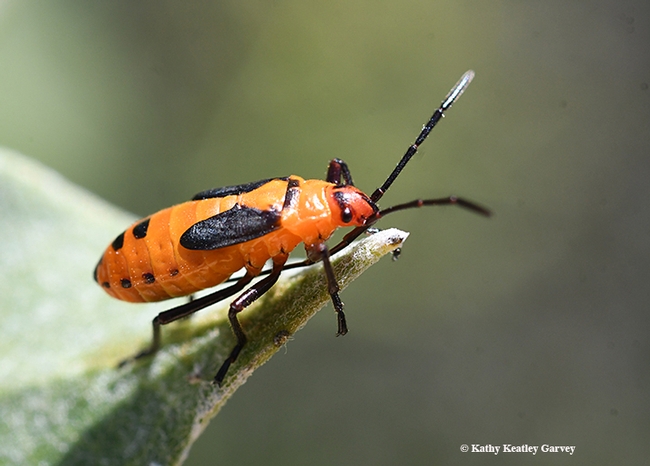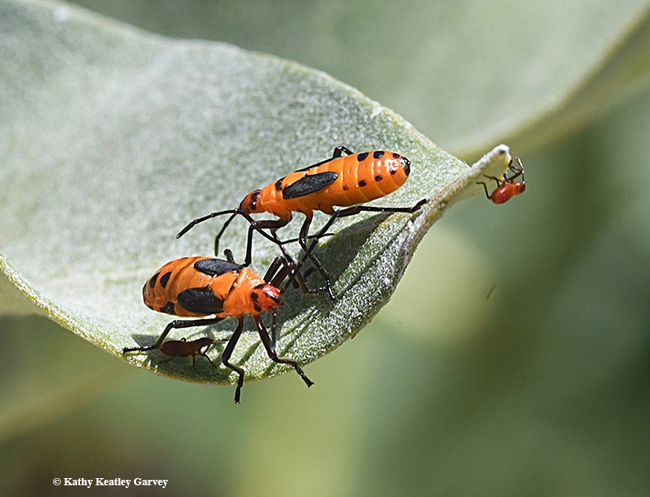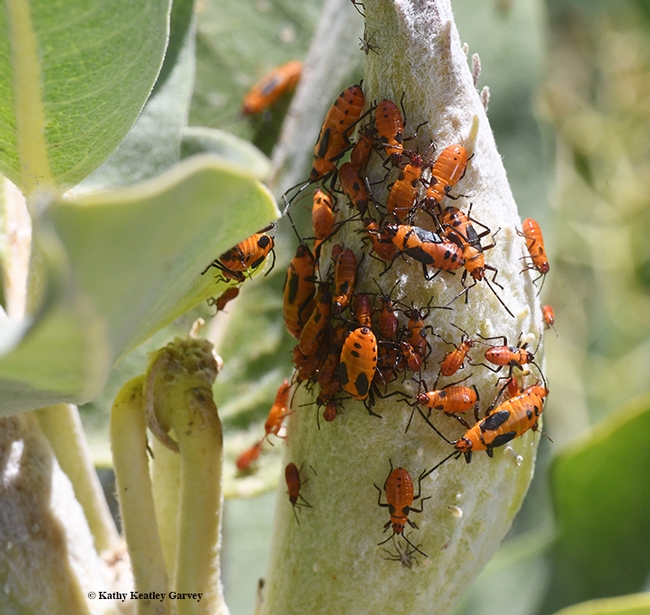- Author: Kathy Keatley Garvey
Have you seen any overwintering milkweed bugs lately?
About a dozen milkweed bugs, Oncopeltus fasciatus, emerged from seclusion Jan. 2, 2022 in our Vacaville garden. The temperature hovered at 32 degrees that morning, but when the sun peeked out, there they were. Mating.
Little early, aren't ya, buddies? If you're waiting for the first milkweed seeds, get set for a long wait.
Jack Frost nailed what was left of most of our milkweed. So where are the colorful reddish-orange/black bugs overwintering? In our nearby cacti and succulents.
Milkweed bugs are known as "seed eaters" of milkweed, but actually they are opportunistic and generalists, according to Hugh Dingle, emeritus professor of entomology at the University of California, Davis. In a September 2019 Bug Squad blog, Dingle told us they will eat monarch eggs and larvae (milkweed is the host plant of monarchs), as well as the oleander aphids that infest the milkweed.
"Milkweed bugs will get protein from wherever they can find it," said Dingle, an insect migration biologist and author of the textbook, Animal Migration: the Biology of Life on the Move. They've been known to feed on insects trapped in the sticky pollen of the showy milkweed (Asclepias speciosa). And on nectar.
Dingle served on the UC Davis Department of Entomology faculty from 1982 to 2002, achieving emeritus status in 2003. National Geographic featured him in its cover story on “Great Migrations” in November 2010. LiveScience interviewed him for its November 2010 piece on “Why Do Animals Migrate?”
But milkweed isn't the only plant that these bugs breed and feed on. "The fascinating thing about milkweed bugs is that they will feed and breed spontaneously on Erysimum and Cheiranthus, two Brassicaceous genera that make cardenolides!" UC Davis butterfly guru Art Shapiro, distinguished professor of evolution and ecology, told us this week.
The amazing world of milkweed bugs and the plants they feed and breed on...
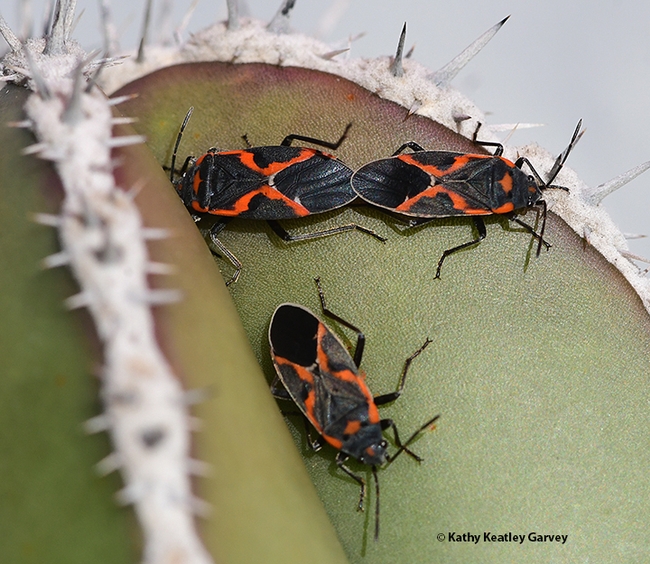
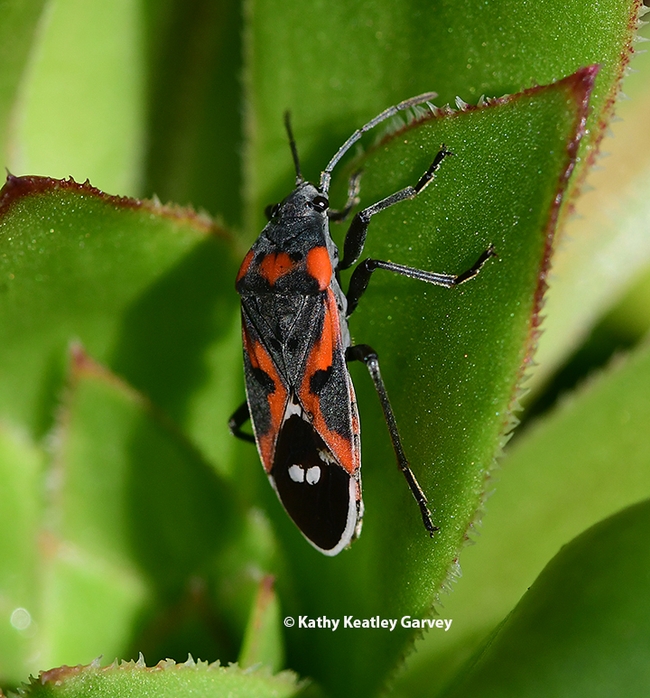
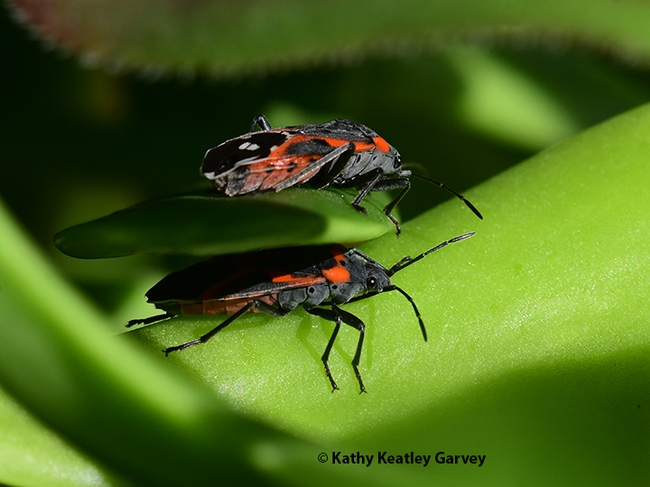
- Author: Kathy Keatley Garvey
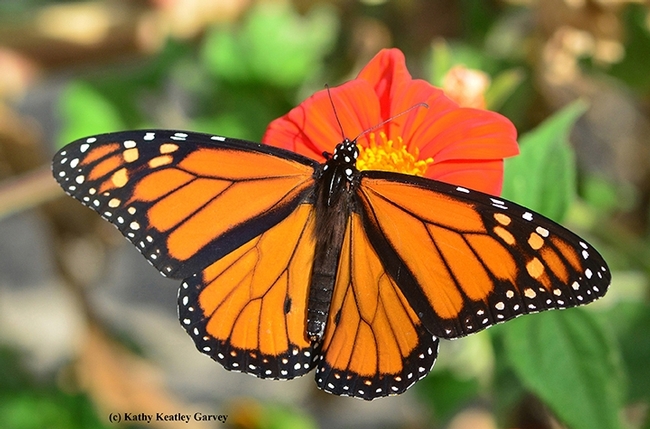
The paper, “Two Centuries of Monarch Butterfly Collections Reveal Contrasting Effects of Range Expansion and Migration Loss on Wing Traits,” appears this week in the Proceedings of the National Academy of Sciences.
The researchers:
- Lead author Micah Freedman, a former UC Davis doctoral candidate in population biology and now a postdoctoral fellow at the University of Chicago.
- Emeritus professor Hugh Dingle of the UC Davis Department of Entomology and Nematology, a noted authority on migrant animal behavior
- Sharon Strauss, professor, Center for Population Biology and the Department of Evolution and Ecology
- Santiago Ramirez, associate professor, Center for Population Biology and the Department of Evolution and Ecology
What they did:
"We measured the wings of 6,000 museum specimens of monarch butterflies collected from 1856 to the present, as well as contemporary wild-caught monarchs from around the world,” Freedman said. "The major implications of the research,” Freedman said, “are that it shows (1) loss of migration can affect the evolution of monarch butterflies over contemporary time scales--dozens to hundreds of years; and (2) monarchs with large forewings are better-suited for long distance movement, and this likely contributed to their global expansion over the past 200 years.”
Their research documents how migration-associated traits may be favored during range expansion but disfavored when species cease seasonal migration. “Furthermore, it highlights the value of museum collections by combining historical specimens with experimental rearing to demonstrate contemporary evolution of migration-associated traits in natural monarch populations,” Freedman said.
Freedman worked closely with Dingle, a UC Davis entomology professor from 1982 to 2002 who achieved emeritus status in 2003. Dingle authored two editions of Migration: The Biology of Life on the Move (Oxford University Press), is a fellow of the American Association for the Advancement of Science, and a past president of the Animal Behavior Society. His research has taken him throughout the world, from the United States to the UK, Kenya, Thailand, Panama, Germany and Australia. National Geographic featured him in its cover story on “Great Migrations” in November 2010. LiveScience interviewed him for its November 2010 piece on“Why Do Animals Migrate?”

The researchers analyzed monarch specimen collections from nearly two dozen museums, including the Bohart Museum of Entomology, University of California, Davis.
The Bohart Museum, located in Room 1124 of the Academic Surge Building on Crocker Lane, UC Davis campus, houses a global collection of nearly 8 million insect specimens. Directed by Lynn Kimsey, professor of entomology and a former chair of the UC Davis Department of Entomology and Nematology, the Bohart is geared toward "Understanding, documenting and communicating terrestrial arthropod diversity," which appears on its logo; see website. (Note that the Bohart Museum is temporarily closed due to the COVID-19 pandemic precautions.)
Said Dingle: “At a time when museum collections are under pressure from a scarcity of funding, the results also show just how valuable such collections can be to evolutionary research and to the understanding of ongoing biological processes in the face of anthropogenic change.”
His comments bear repeating:
That bears repeating: “At a time when museum collections are under pressure from a scarcity of funding, the results also show just how valuable such collections can be to evolutionary research and to the understanding of ongoing biological processes in the face of anthropogenic change.”

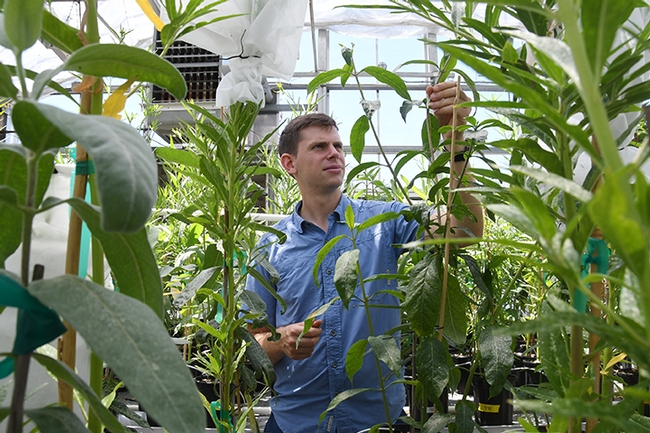
- Author: Kathy Keatley Garvey
So here are all these milkweed bugs clustered on a showy milkweed leaf, Asclepias speciosa. It's early morning and the red bugs are a real eye opener.
They're seed eaters, but as Hugh Dingle, emeritus professor of entomology, UC Davis Department of Entomology and Nematology says: "They are opportunistic and generalists." They not only eat seeds, but monarch eggs and larvae, as well as the oleander aphids that infest the milkweed.
But wait, one of these is not like the other.
A lady beetle, aka ladybug, photobombs the scene. It sleeps with them and eats (aphids) with them. They are sharing the same food source: oleander aphids.
Goodbye, aphids!
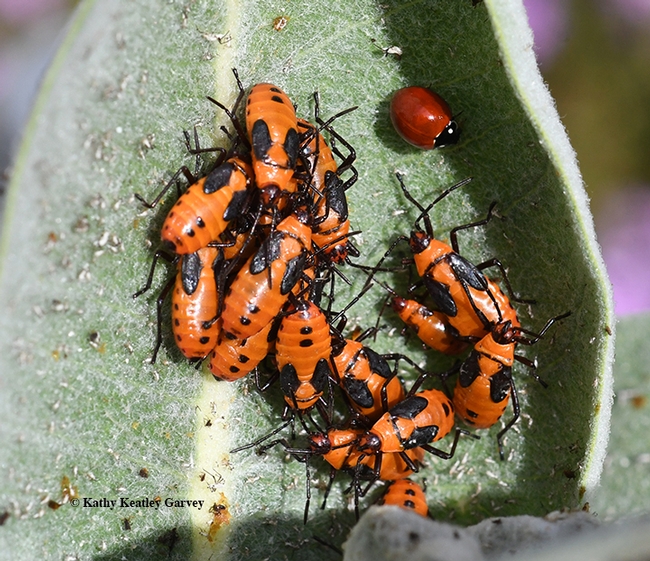
- Author: Kathy Keatley Garvey

Milkweed bugs gained the nickname of "seed eaters" for primarily eating the seeds of milkweed.
Actually, they are opportunistic and generalists, says Hugh Dingle, emeritus professor of entomology at the University of California, Davis.
They will eat monarch eggs and larvae (milkweed is the host plant of monarchs), as well as the oleander aphids that infest the milkweed.
We recently watched a large milkweed bug (Oncopeltus fasciatus) munch oleander aphids on a narrow-leafed milkweed (Asclepias fascicularis) in our pollinator garden in Vacaville, Calif. Between the milkweed bugs and the lady beetles, aka ladybugs), they absolutely cleaned off all the aphids, the first time in years.
Milkweed without aphids? Unbelievable! That's like macaroni without cheese, a pencil without paper, or a hammer without a nail. It's a "given" that if you grow milkweed, you'll get aphids. Some monarch butterfly enthusiasts kill the aphids with a soapy water mixture (which we've done in the past), but this year, we let biocontrol reign.
It worked wonderfully!
"Milkweed bugs will get protein from wherever they can find it," says Dingle, an insect migration biologist and author of the textbook, Animal Migration: the Biology of Life on the Move. They've been known to feed on insects trapped in the sticky pollen of the showy milkweed (Asclepias speciosa). And on nectar.
Dingle served as a professor at UC Davis Department of Entomology from 1982 to 2002, achieving emeritus status in 2003. National Geographic featured him in its cover story on “Great Migrations” in November 2010. LiveScience interviewed him for its November 2010 piece on“Why Do Animals Migrate?”
A fellow of the American Association for the Advancement of Science and the Animal Behavior Society, Dingle has done research throughout the world, including the UK, Kenya, Thailand, Panama, Germany and Australia.
Dingle is a former secretary of the International Society for Behavioral Ecology and past president of the Animal Behavior Society. He received the Edward A. Dickson Professional Award in 2014 to do research on "Monarchs in the Pacific: Is Contemporary Evolution Occurring on Island Islands? (See news story on Department of Entomology and Nematology website.)
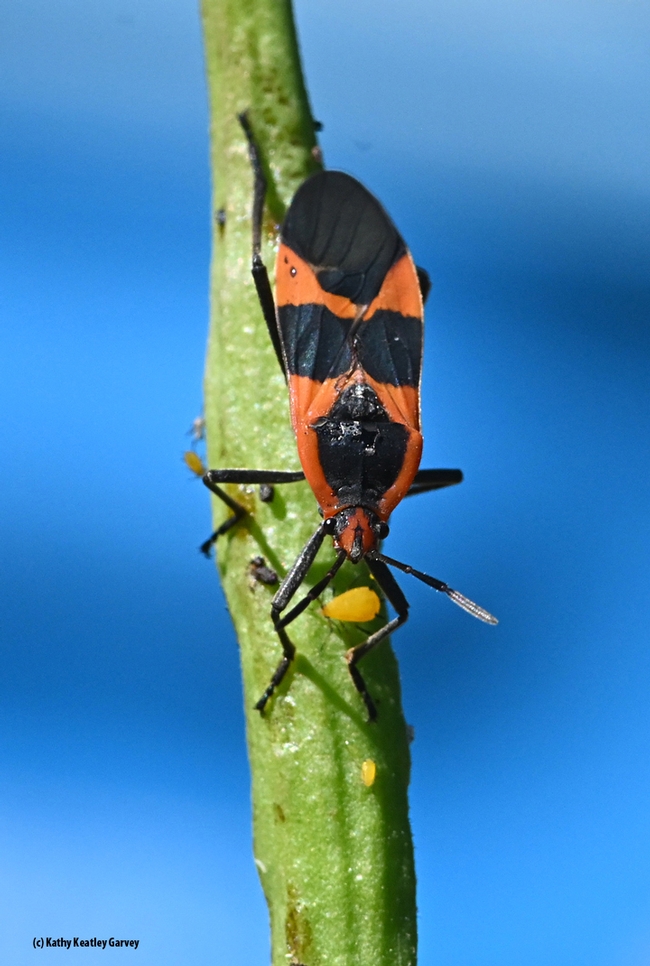
- Author: Kathy Keatley Garvey
If you've been finding more milkweed bugs than monarchs on your milkweed, join the crowd.
Monarchs are scarce--at least around Solano and Yolo counties--but milkweed bugs are quite plentiful. Sometimes you see them massing on milkweed pods as if they're having a family reunion and trying to figure out who's who during an all-you-can eat buffet. They're blood red, in sharp contrast to the green plants.
Have you seen the large milkweed bugs, Oncopeltus fasciatus, and the small milkweed bugs Lygaeus kalmii? Both belong to the seed bug family, Lygaedidae. We recently spotted small milkweed bugs on a patch of showy milkweed (species Asclepias speciosa) in Sonoma.
Milkweed bugs are primarily seed eaters, but they're opportunistic and generalists, says Hugh Dingle, emeritus professor of the UC Davis Department of Entomology and Nematology, an insect migration biologist who also researches migratory monarchs.
"They'll get protein from wherever they can find it," said Dingle, author of the popular textbook, Animal Migration: the Biology of Life on the Move. They eat not only eat seeds, but also monarch eggs and larvae and the immature stages of other butterflies, Dingle told us back in 2016. They eat other small bugs and feed on nectar as well. Some scientists have seen them feeding on insects trapped in the sticky pollen of the showy milkweed. (Read about the opportunist Small Milkweed Bug in the Journal of the New York Entomological Society.)
The bugs feed on the toxic milkweed, rendering them distasteful to predators. Their warning colors (red and black) also tell prospective predators "Leave me alone; I don't taste good. If you eat me, you'll be sorry." They sequester and store cardenolides (cardiac glycosides) from the milkweed.
In the fall, as the seed pods burst open, monarch enthusiasts scramble to collect the seeds for next year, but they usually have to compete with the red invaders.
If they're still around...
